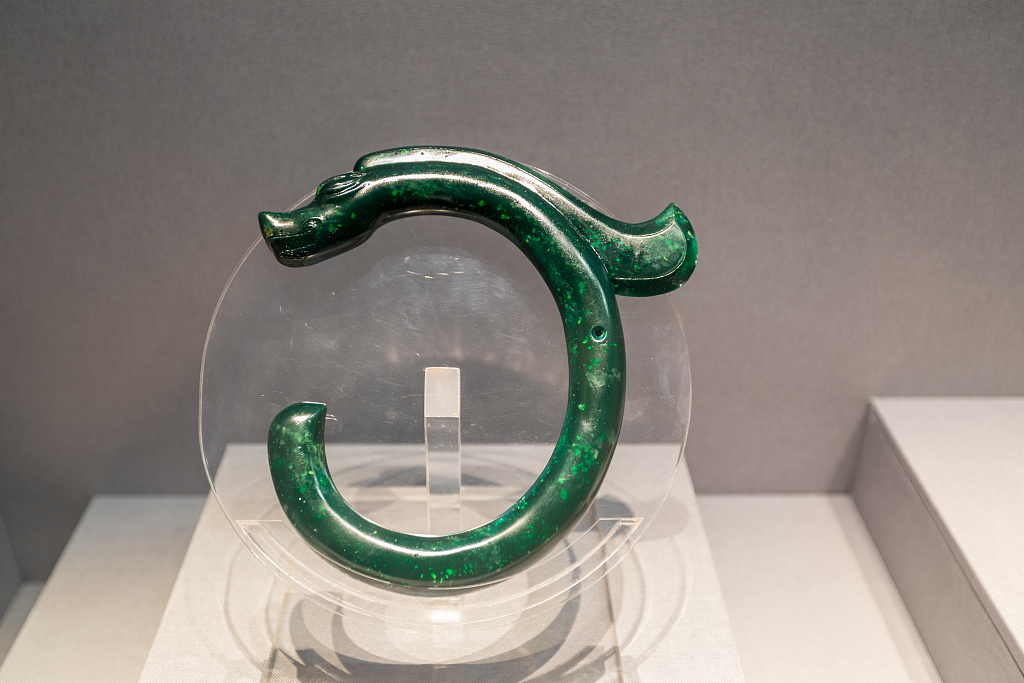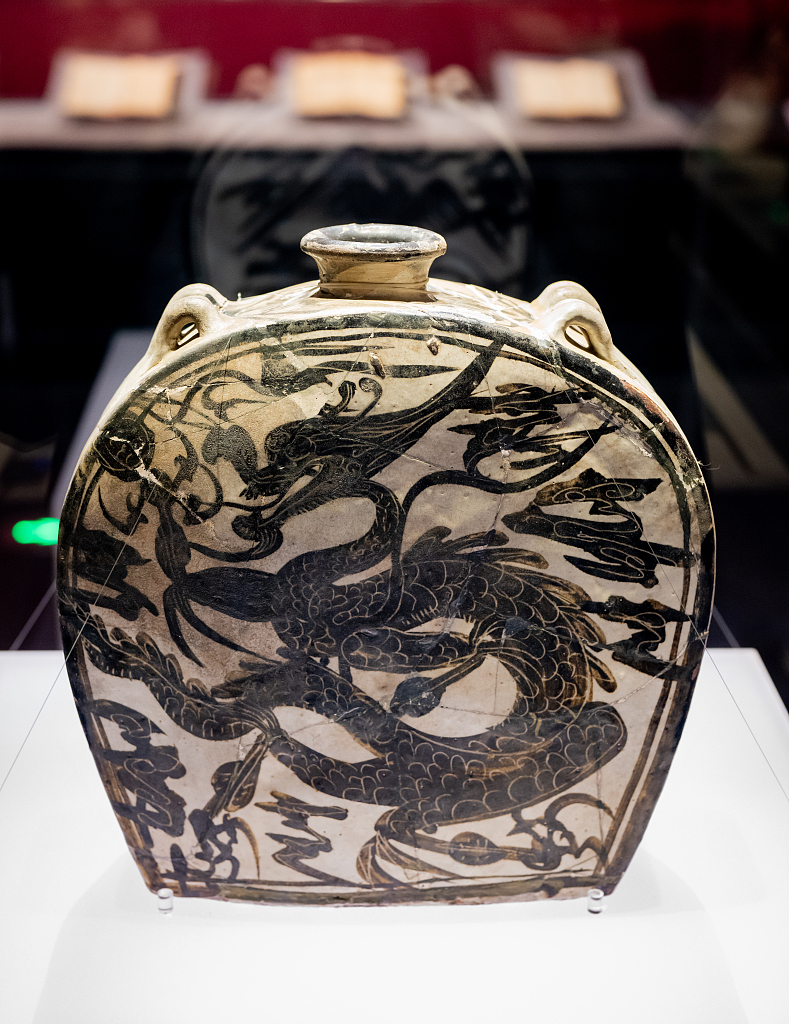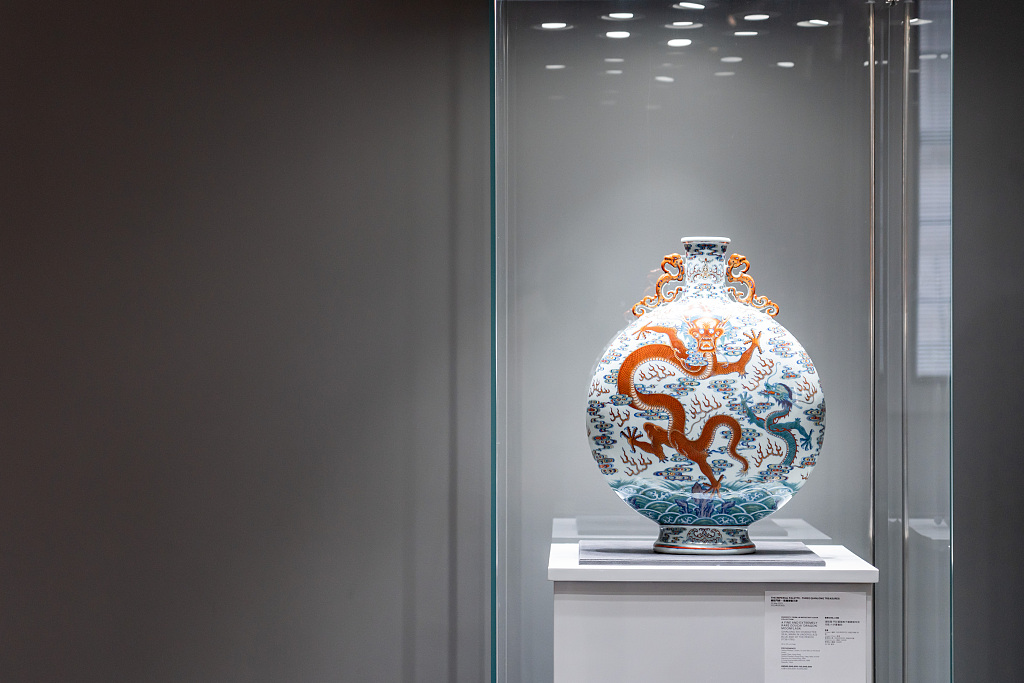
A file photo shows a standing dragon statue from the Tang Dynasty (618-907) made with copper and iron, with gold gilding on the surface. The statue is popular at the Shaanxi History Museum. Its body has a dynamic flow, representing the vivid beauty of a dragon in ancient people's perception. /CFP
A file photo shows a standing dragon statue from the Tang Dynasty (618-907) made with copper and iron, with gold gilding on the surface. The statue is popular at the Shaanxi History Museum. Its body has a dynamic flow, representing the vivid beauty of a dragon in ancient people's perception. /CFP

Photo taken on August 10, 2023 at the Chifeng Museum shows the C-shaped jade dragon from the Hongshan Culture. Widely known as the "First Dragon of China," it is regarded as the archetypal ancient depiction of a dragon. The Hongshan Culture is predated to have originated around 5,000 years ago. /CFP
Photo taken on August 10, 2023 at the Chifeng Museum shows the C-shaped jade dragon from the Hongshan Culture. Widely known as the "First Dragon of China," it is regarded as the archetypal ancient depiction of a dragon. The Hongshan Culture is predated to have originated around 5,000 years ago. /CFP

Photo taken on November 3, 2023 shows a flat, arched flask painted with a three-clawed dragon dating back to the Ming Dynasty (1368-1644). /CFP
Photo taken on November 3, 2023 shows a flat, arched flask painted with a three-clawed dragon dating back to the Ming Dynasty (1368-1644). /CFP

Photo taken on November 4, 2023 at the Minhang Museum in Shanghai shows a head decoration piece made for the grandmother of the Wanli Emperor in the Ming Dynasty (1368-1644). The crown boasts twelve dragons, nine phoenixes, and more than a hundred gemstones, weighing over 2.5 kilograms. /CFP
Photo taken on November 4, 2023 at the Minhang Museum in Shanghai shows a head decoration piece made for the grandmother of the Wanli Emperor in the Ming Dynasty (1368-1644). The crown boasts twelve dragons, nine phoenixes, and more than a hundred gemstones, weighing over 2.5 kilograms. /CFP

Photo taken on May 14, 2023 shows a moon-shaped flask dating back to the Qianlong Emperor of the Qing Dynasty (1644-1911) on auction by Christie's auction house. On its body, a green five-clawed dragon emerges from waves to confront an ascending, iron-red dragon amid cloud scrolls and flames. /CFP
Photo taken on May 14, 2023 shows a moon-shaped flask dating back to the Qianlong Emperor of the Qing Dynasty (1644-1911) on auction by Christie's auction house. On its body, a green five-clawed dragon emerges from waves to confront an ascending, iron-red dragon amid cloud scrolls and flames. /CFP

Photo taken on June 7, 2023 at the Dalian Museum shows a silk robe embroidered with five dragon patterns. The robe was made for the Guangxu Emperor of the Qing Dynasty (1644-1911). Dragon robes were a symbol of imperial power. /CFP
Photo taken on June 7, 2023 at the Dalian Museum shows a silk robe embroidered with five dragon patterns. The robe was made for the Guangxu Emperor of the Qing Dynasty (1644-1911). Dragon robes were a symbol of imperial power. /CFP
The dragon is among the 12 animals of the Chinese zodiac. The 2024 Chinese New Year is the Year of the Dragon in the 12-year cycle. The dragon pattern is regarded as a symbol of power and authority and was associated with the emperors of China in ancient times. We've rounded up a slew of ancient relics that feature dragon patterns.







